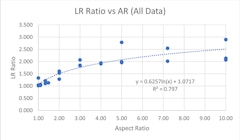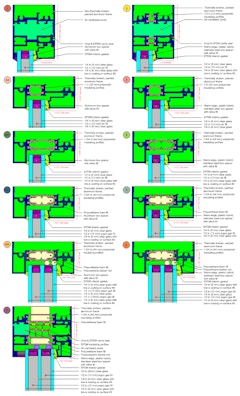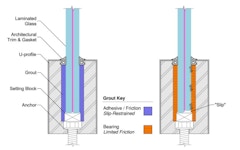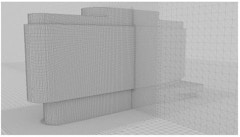29 results
-
Glass structural elements have become increasingly common to the point of ubiquity; however, there currently is no universally recognized and…
-
Interstitial condensation risk assessment
- Paper by Jelle Langmans, Partner at Physibel Piet Houthuys, Senior developer at Physibel Wout Parys, Partner at Physibel Staf Roels, Full professor at KU Leuven
The development of methods to predict and control moisture accumulation in building envelopes has always been a key element in building science.… -
3D thermal modelling of complex facades
- Paper by Wout Parys, Partner at Physibel Piet Houthuys, Senior developer at Physibel
Today’s building enclosures face ever greater demands regarding their thermal performance. In cold climates, the required total U-value of the façade… -
Determination of Surface Flaw Parameters for Annealed and Fully Tempered Glass Exposed to NaCl
- Paper by Nabhajit Goswami, PhD, Senior Facade Engineer Joshua Schultz, PhD, PE, LEED AP, Associate Professor Patrick Ferro, PhD, PE, MBA, Professor Stephen M Morse, PhD, PE, Associate Teaching Professor, Mechanical Engineering-Engineering Mechanics Affiliated Assistant Professor, Civil, Environmental, and Geospatial Engineering
The use of glass in the exterior facades provides greater light transmission into the building and improved views for occupants. Coastal areas in… -
Advanced Simulation for Thermal Stress Assessment
- Paper by Andrea Zani · Jamie Reyes · Guido Lori · Jacob Hanke · Giacomo Zangiacomi
In recent years, the desire for increased performance, transparency and visual flatness of glazing elements in curtain walls has generated renewed
-
Blast Performance
- Paper by Jon Kimberlain · Jie Feng · Will Wholey · Dan Aggromito · Valérie Hayez
Designing for blast performance for glazing units can be very complex. The test methods for evaluating performance include subjecting units to actual
-
Structural Silicone Sealant and Glass Fins
- Paper by Jon Kimberlain · Valerie Hayez · Jie Feng
Structural silicone sealant is commonly used in glass fin applications, both as a weatherseal and as for structural attachment. A common concern for
-
Attention to Overheating in Curtainwall Buildings
- Paper by Yuzhen Zhou NFRC CS, LEED AP, Technical Director at Warmframe Technology
Several years ago, Technoform and the Solar Energy Research Institute of Singapore (SERIS) researched the thermal performance of different aluminum… -
Insulating Glass Unit Gas Loss
- Paper by Mark K. Schmidt, M.Eng., S.E. · Stephen M. Morse, PhD, P.E.
Concerns over time-dependent argon permeation through the perimeter edge seals of insulating glass units (IGUs) led the authors to utilize two
-

Thermal Bridging and Building Facades
- Paper by Ivan Lee,
Thermal bridging through building façades have been overlooked by designers and building energy codes and standards in the past, which has led to… -
Comparison of Historical Weathered Annealed Glass Failure Data to ASTM E1300
- Paper by Nabhajit Goswami; Student, ngoswami@mtu.edu Stephen M Morse; Assistant Professor, Civil and Environmental Engineering Assistant Professor, Mechanical Engineering-Engineering Mechanics Michigan Tech University, smmorse@mtu.edu
Historical published weathered annealed failure data consisting of 13 samples were collected and glass failure prediction model surface flaw… -

Fixed Edge Supports
- Paper by James G. Soules, Ph.D., P.E., S.E., P.Eng., SECB, F.SEI, F.ASCE · Stephen M. Morse, Ph.D., P.E., M.ASCE · Scott H. Norville, P.E., Ph.D.
Model building codes and standards in the United States use a probabilistic model to define glass load resistance (LR). In general, these model
-

SSG and Seismic
- Paper by Jon Kimberlain, Senior Scientist Valerie Hayez, Senior Scientist Jie Feng, Research Scientist Mark Mirgon, R&D Technologist
With the advent of more sophisticated analysis methods and the desire to optimize geometries of structural silicone joints in high performance… -

Structural Silicone Glazing
- Paper by Jon Kimberlain · Yvonne Diaz · Andrew Dunlap · Adrienne Bowman-Grittini
The recent 50 year anniversary of the first use of silicone sealant in a 4-sided structural silicone glazing application marks a sustainable and
-

Condensation Study of Windows
- Paper by Ajla Aksamija · Suncica Milosevic · Helen Sanders · Alexandra Blakeslee
This paper discusses a simulation study of different window systems, where heat transfer simulations were performed to investigate thermal
-

Advances in Effective Thickness
- Paper by Adam J Nizich, P.E. · Andrea M. La Greca, P.E. · Laura Galuppi, PhD
Effective thickness is a simplified method for the structural evaluation of laminated glass section properties. The method consists of defining the
-

The Thermal Blanket Concept
- Paper by Bharat Patel, PE, CEM, LEED AP, Michael Bulander, AIA, LEED AP,
This paper tells the story of a Double Skin Facade (DSF), where high performance and multi-disciplinary collaboration saves a library concept of… -
Retrofit Options for Historic Facades
- Paper by Carrie Davis, P.E., LEED Green Assoc. · George Kantrales, Ph.D. · Matt Barsotti · Andrew Schoenheit · Ty Vandergriff
Building design criteria requires that government buildings be designed for a variety of extreme loads including blast, hurricane, and impact
-

Glazed Spandrels
- Paper by Julien Schwartz, M.Eng., Patrick Roppel, M.A.Sc, P.Eng., Stéphane Hoffman, M.Eng, M.Arch, P.Eng, P.E., Neil Norris, M.A.Sc, P.Eng, C.P.H.D.,
Recent years have seen an increased use of insulated glazing units in spandrel applications to visually blend the appearance between the vision and… -
Facade Wind Loading
- Paper by Timothy Brewer, CEng, MICE · George Kantrales, Ph.D. · Eric Sammarco, Ph.D., P.E. · Carrie Davis, P.E., LEED Green Assoc.
Wind induced pressure is a major design consideration for building facades. However, the effects of facade geometry and urban terrain on wind loading

